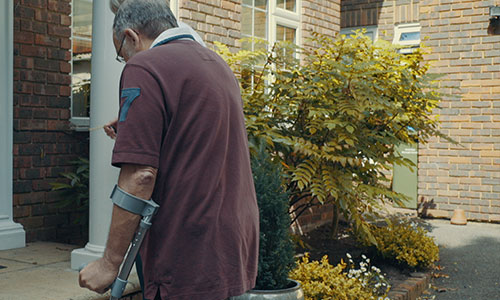Exercises after hip replacement
- Overview
- Full article
- Related articles
Having a hip replacement, hip resurfacing or other major hip surgery is a big event in anyone’s life. It may seem daunting at first, but with a bit of work recovery can be swift.
It all begins with preparation. In the weeks ahead of your operation you should begin a series of simple exercises to build strength in your hip. These are the same exercises you’ll do in the initial stages of recovery, so it’s a good idea to get used to them and form a routine before surgery. They’ll suit most patients, but check with your surgeon or physiotherapist first.
See how quickly Derek recovered from his hip replacement.
Standing Hip Abduction
- Stand straight beside a steady object like a table or chair, use the object to maintain balance
- Move your operated leg out to the side, without lifting your pelvis. Keep your toes pointed forward
- Return your foot to the floor and repeat ten times. Do three sets a day.
Hip Extension
- Whilst standing, face a steady object like the back of a chair or a bench, take hold of it to maintain your balance
- Gently lift your leg behind you, keeping both your leg and back straight and looking directly ahead of you
- Don’t worry about how far it goes, just make sure you’re comfortable. Return your foot to the floor and repeat ten times. Do three sets a day.
Standing Calf Raise
- Stand in front of a table and hold on to help keep your balance
- Go up and down slowly on your tiptoes ten times. Do three sets a day.
Hip Flexion
- Raise your knee to the level of your hip, forming a 90 degree angle at the hip, or as close to it as you can manage comfortably
- Drop your knee and lower your foot to floor. Repeat 10 times. Do three sets a day
- Don’t raise your hip above 90 degrees until your physio or surgeon tell you otherwise.
Getting back to your best
In the days following your operation it’s important to rest, but your recovery depends on gradually increasing your activity every day.

Your physio will help you decide when the time is right to set aside your walking aid. Most patients are free of all aids within six weeks. You may find these crutch-use guides handy:
Alongside your exercises you should take small walks, gradually building up the distance when your physio says you’re ready. There’s no rush, do only what you feel you can manage.
Your rate of recovery depends on your own circumstances, but your physiotherapist will help you set goals and stay on track, so you can get back on your feet faster.
Last updated Friday 2 September 2022
First published on Friday 14 October 2016
